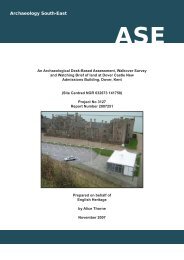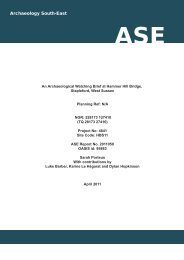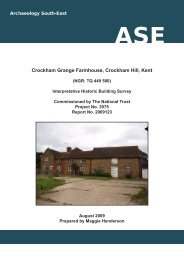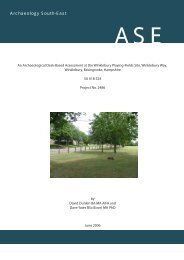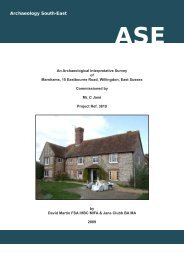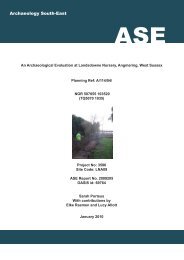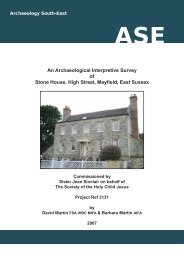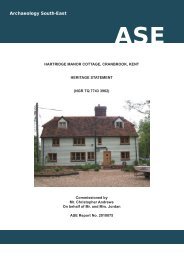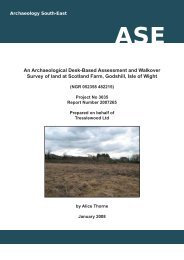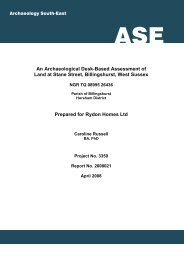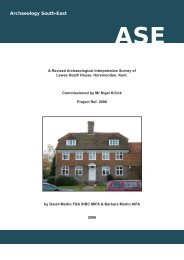ASE front cover - Archaeology South-East
ASE front cover - Archaeology South-East
ASE front cover - Archaeology South-East
You also want an ePaper? Increase the reach of your titles
YUMPU automatically turns print PDFs into web optimized ePapers that Google loves.
<strong>Archaeology</strong> <strong>South</strong>-<strong>East</strong>2008058: Holbury Infants School, Holbury, Hampshirecould possibly have intersected just outside the area excavated forming partof an enclosed or a partially enclosed area. Linear A ([1012], [1075], [1079],[1086] and [1094]) was situated to the northeast of the area, alignednorthwest-southeast and east of the discreet features. Linear B ([1073],[1082], [1084] and [1091]) was situated to the southeast of the areainvestigated, aligned northeast-southwest to the south of the discreetfeatures. The three possible quarry pits [1004], [1009] and [1010] (Figs. 5and 11) were located to the northwest of the area investigated, to thesouthwest of linear A. The two possible hearth features [1051] and [1057],and inter-cutting feature [1050] (Figure 11) were located to the northwest oflinear B. The pit [1047] and two smaller pits or postholes [1045] and [1043]were situated to the north of this.4.1.6 A large number of trees (Figure 10) were removed during site clearancework prior to the start of archaeological works. The tree <strong>cover</strong>age extendedover much of the southern part of the excavation area and the associatedroot disturbance had a detrimental effect; the edges of several features inthe southern half of the site were diffuse due to root damage, in particularpossible hearths [1051] and [1057] and linear B, most notably within section[1073].4.2 Linear A (Figure 7, Sections 1-5)4.2.1 The full extent of linear A was not visible within the excavation area; itcontinued to the north towards the direction of the housing estate and to thesouth, towards linear B. The maximum visible length measured 35m. Fivesections [1012], [1075], [1079], [1086] and [1094] (Figure 7, Sections 1-5)measuring between 1m and 1.20m each were excavated. The linear had abroadly U-shaped profile, measuring between 1.11m and 1.30m in widthand 0.40m to 0.67m in depth. Two fills were recorded in three of thesections: [1075], [1079] and [1094]. One section [1086], showing evidenceof natural slumping, contained three fills. The remaining section [1012] wasbadly damaged by root disturbance and only one fill was observed.4.2.2 Section [1012], (Figure 7, Section 1) was broadly U-shaped in profile, thesouth-western edge sloping more steeply. There was evidence of severeroot disturbance and the edges were diffuse. It was filled by a light yellowishbrown silty sand with occasional stones, and produced a small group ofpottery dated from AD 270 to the early/mid 4 th century [1013].4.2.3 Section [1075] (Figure 7, Section 2) had a broadly U-shaped profile, with afairly flat base. The primary fill [1076] was an orangey greyish brown clayeysand with occasional small gravel inclusions which contained a fragment ofrotary quern stone [1076]. The secondary fill [1077] was a greyish yellowishbrown silty sand with lenses of slity clay and occasional small stones andgravel inclusions, which produced pottery dated from AD 270 to theearly/mid 4 th century and a single piece of worked flint. This was a smallhoney-coloured flint nodule with buff cortex, which has been utilised as acore of probable Later Neolithic or Early Bronze Age date and is consideredto be residual in this context.4.2.4 Section [1079] (Figure 7, Section 3) had a broadly U-shaped profile. Theprimary fill [1080] was a light brown clayey sand with moderate gravelinclusions. The secondary fill was a mottled light yellowish brown and8© <strong>Archaeology</strong> <strong>South</strong>-<strong>East</strong>



